The Phoenix lander team revealed the latest images from the mission at a press briefing on Friday. This first image shows an area dug by Phoenix’s scoop, which disclosed a bright surface just a few inches down, which may be ice. “There’s still some debate about the bright material,” said Phoenix Principle Investigator Peter Smith. “Not everyone is sure that this is ice. So there’s been some debate on our team, centering around that perhaps there’s a salt layer just under the soil that also would be bright. Everyone does believe there’s ice under the surface, and whether this is ice or not is the question. The other question is, is this thick ice that goes down deep beneath the surface, or is this a thin layer and we’ll be able to scrape through? So being able to scrape with our scoop is a high priority for us.”
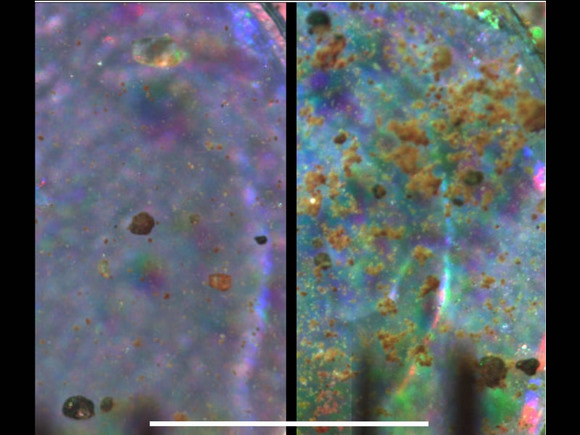
This pair of images taken by the Optical Microscope on NASA’s Phoenix Mars Lander offers a side-by-side comparison of an airfall dust sample collected on a substrate exposed during landing (left) and a soil sample scooped up from the surface of the ground beside the lander. In both cases the sample is collected on a silicone substrate, which provides a sticky surface holding sample particles for observation by the microscope.
Similar fine particles at the resolution limit of the microscope are seen in both samples, indicating that the soil has formed from settling of dust.
The microscope took the image on the left during Phoenix’s Sol 9 (June 3, 2008), or the ninth Martian day after landing. It took the image on the right during Sol 17 (June 11, 2008).
The scale bar is 1 millimeter (0.04 inch).
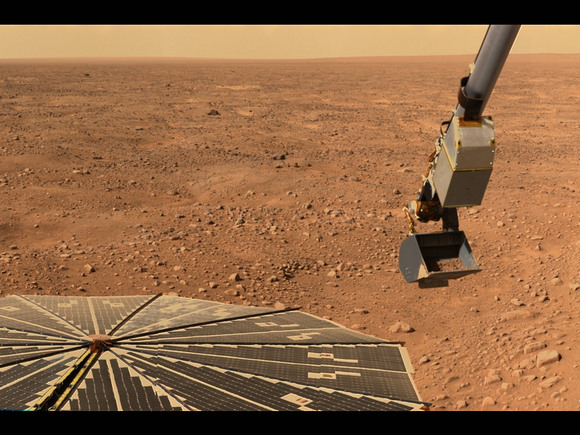
This is the latest color image of Phoenix, its surroundings and the scoop with soil.
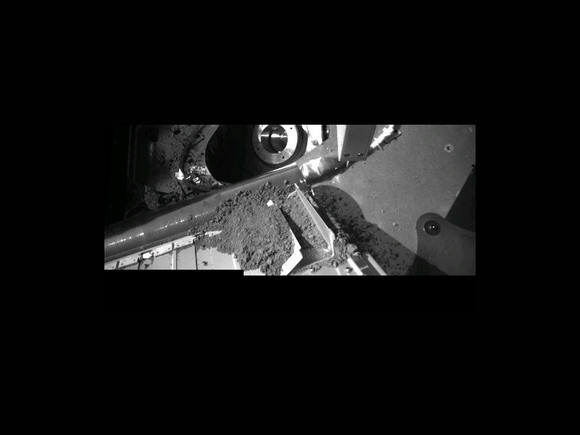
While we can’t look inside the Thermal and Evolved Gas Analyzer (TEGA) oven which will “bake” the Martian soil to test the type of gases that are released, we can see that some of the soil has gone into TEGA. “We were finally successful and some of the material has slid down over the screen” said Smith, “sort of like material going over a cheese grater, and some of the material has slid down and filled the oven. We sent the commands for the first operation of TEGA last night, but we don’t have our data back yet, so we can’t report on any results. That will be coming later next week. So this is a very exciting time for us. We find the soil is very clumpy, it’s sticky, it’s an unusual soil not at all like the types of soils we used in our tests, which worked just fine with all the instruments. So we’ve developed another method of collecting samples, which is to tilt the scoop and vibrate it, and so it shakes down a small amount of material onto the instruments.”
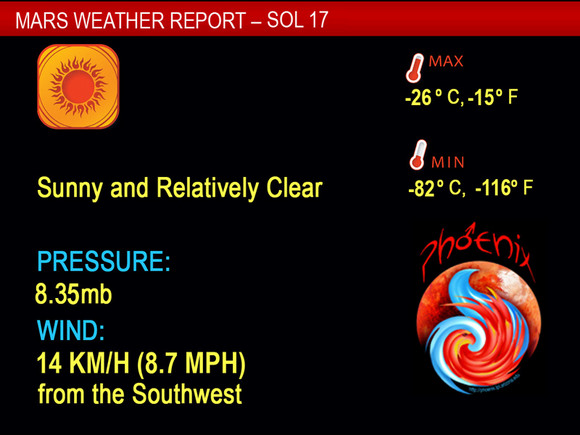
And finally, here’s the latest weather report for Mars, on the 17th sol of Phoenix’s stay on Mars.
Sources: Phoenix News, NASA TV

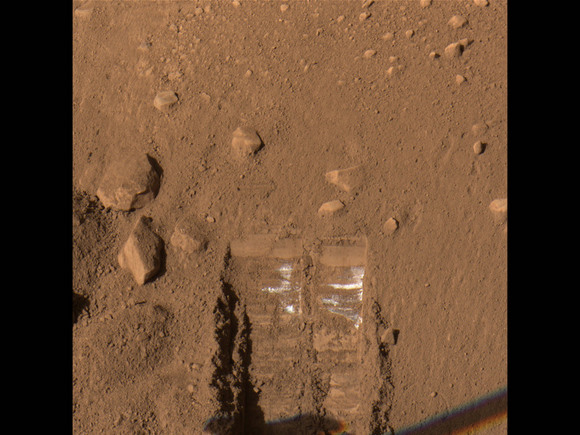
We just need someone up there to put their tongue on it. That will give us a quick answer!
Just don’t lick the lander, you’ll stick to it.
NASA can detect oceans on Europa and cannot tell the difference between ice and salt on Mars with a lab?
Be serious.
I really hope it is ice..
Seems like it would be easy to determine if it’s ice: just wait a week and see if it’s still there in the trench. If it’s ice, the exposed surface will likly sublimate over time, so that the white patches will disappear. If it’s salt, it’ll still be there a year from now.
They detected plenty of water (ice) there.. That is why they landed there.. But we are just looking at a picture at the moment. I guess they need to scrape it up and find out.. Which they will do..
It’s cocaine. No wonder we’re so eager to go there.
Great! There’ll be an exodus!!
I triple-dog-dare you, Tom. 😀
What happens to the sample’s after they are situated in the ovens. Are the ovens then deemed usless because of hoding waste product. How do they remove the soil once it is analised. Dave from England
Only 15 below for the high temperature. Mars must be like Minnesota.
Dave —
The ovens can only be used once, — the materials inside can’t be emptied and the ovens can’t be reused. There are 8 ovens in TEGA, so Phoenix only gets 8 chances to bake the Martian soil.
I’m betting it’s salt or some other white material. Even with a surface coating of dirt I would imagine water ice would “freeze dry” and evaporate over time.
It looks like Johnson’s Baby Powder to me..
Salt is only white if it is purified. There isn´t anybody on Mars who can do that job of separating brown soil from white salt.
Some time ago ist was proven that a layer of water ice some 3 km thick covers the north pole tegion of Mars. This is where Phoenix landed, and this is the reason why Phoenix landed THERE.
In permafrost regions like those at the northern coast of Alaska, there is a massive layer of white ice lying right under a thin layer of soil, and the polygonic surface pattern that soil displays is very similar to the pattern Phoenix has photographed at its landing site.
The fact that the soil at the landing site is so sticky is puzzling. Perhaps there are hygroscopic salt particles in the soil which attract water molecules that emanate from the ice below, these wetted salt particles might cling to the soil particles, thus making the soil sticky.
Regards,
Günther
That seems to be the consensus, but the TEGA results will give us a lot more clues
Salt is quite a vague term!
I wonder how the topsoil got spread so thickly over the ice sheet.
buried UFO
I guess it is too warm for it to be CO2 ice.
I am betting on this being ice.
Now, if the ice is full of little cryophilic fellas…..
could the soil be some sort of clay? that might explain some of the ‘sticky’ soil.
Haven’t you heard of simulated reality? The white stuff is whatever our creators put there for us to believe it is. We probably took them by surprise and they are just buying some time now to figure out what to put there for us. It’s just like in quantum reality – it’s not that we don’t know what it is, it’s just nothing until we do the experiment to figure out what it is.
I guess it’s paper – probably KGB files buried there by past soviet missions looking for a secure place.
Robert…
It’s “Clay…Bill Clay.”